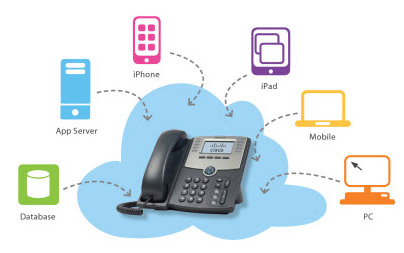Voice-over Internet Protocol (usually referred to as VoIP) is a system for connecting calls that uses digital rather than analogue technology. It is fast becoming popular with businesses of all sizes, not least because of the major savings it can provide on call charges. There are other advantages to VoIP apart from the cost of individual calls, and it is easy to see why so many major corporations, small to medium businesses and even domestic telephone users are making the switch from the old analogue landlines. But what exactly is VoIP, and how does it work?

Traditional landlines rely on something called circuit switching. Put simply, the process by which one telephone connects to another is via a circuit being switched in an intervening exchange. A local call can be connected more quickly, and more cheaply, than an international one. This is the way telephones have been connected to one another worked since their inception.
With a VoIP system, the network is the Internet, and this is the means by which information is sent from computer to computer. Data is divided into small packets which come with identifying information attached to them. These packets are sent across the network to be reassembled into recognisable information for the receiver. Unlike with an analogue phone call, the line is not left open constantly; this would involve transmitting too much unnecessary data. With a VoIP call it is only the sounds that are made by the speakers that are transmitted.
In the same way that you can just as easily connect to a website from a foreign country as one in your own country, there is no difference in the speed or quality of national and international calls when using a VoIP network. Crucially, the person on the other end of the line does not have to be connected to the Internet to receive the call. Thanks to gateway services you can make a VoIP call to a landline telephone.

VoIP has actually existed for a long time; it was first tested in the US in the 70s, but it is only since the Internet came to dominate communications that VoIP has grown into the leading contender for telephony systems. At first, due to problems with the amount of data being transported in the packets, there were problems with the sound quality of VoIP phone calls.
During the 90s and early 2000s, although the Internet was gaining a huge user base, most people still preferred to use traditional analogue landlines, citing VoIP calls’ inferior sound quality as the main reason. In recent years, however, the quality of sound available on a typical VoIP call has improved dramatically, to the extent that it is now almost impossible to distinguish a digital call from an analogue one based on the sound of the voice at the other end of the line.
A common misconception about VoIP is that all calls must be made from computer to computer. While this method is common, there are in fact a number of possibilities for connecting to other people. Here are the main ways to connect using VoIP.
Computer to computer: This is probably the easiest way to use VoIP. As with instant messaging, you can contact another person’s computer. For a telephone call, both parties will need to have either a headset, or speakers and a microphone on their PC or laptop.
Analogue Telephone Adapter (ATA): With an ATA, you can connect a standard analogue telephone to a computer and Internet connection, making it possible to conduct VoIP phone calls with the same phone that you used previously. Essentially, the ATA converts the analogue information from your phone into digital data that can be sent in a packet for transmission. The ATA can be connected to your phone and computer very easily.
IP Phones: This is a type of phone that is itself connected to the Internet, which means that there is no need for an adapter. Almost identical in appearance to standard analogue phones, IP are different only in that they come with an ethernet connector.
The main advantage of VoIP is cost. A VoIP to VoIP call costs nothing to make, the only charge is for that of the broadband connection. There is a small charge when making a VoIP call to a landline, and for receiving calls on a VoIP network from a landline. This is because the gateway provider needs to convert the analogue information into a digital packet. However, these charges tend to be considerably less than typical charges for landline-to-landline, or mobile-to-mobile, phone calls, particularly when it comes to making international calls.